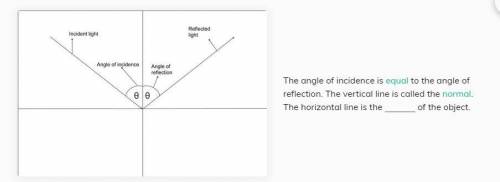
Physics, 31.01.2022 18:00 laceybudd9472
The angle of incidence is equal
equal to the angle of reflection. The vertical line is called the normal
normal. The horizontal line is the _ of the object.


Answers: 1


Another question on Physics

Physics, 21.06.2019 23:00
We want to calculate the total metabolic heat generated by a singing canary taking into account heat transfer by radiation, convection and exhaling air. the air temperature is 20 oc, canary’s body internal and surface temperature is 33oc, external body surface convective heat transfer coefficient is 25.2 w/m2 .k, temperature difference between the inhaled and exhaled air is 4.3 oc, the ventilation rate is 0.74 cc of air per second, specific heat of air is 1.0066 kj/kg.k and density of air is 1.16 kg/m3 . assume the canary’s body to be a cylinder with 7 cm diameter and 9 cm length, and heat exchange is from the side as well as the top and bottom of cylinder. calculate 1) the net rate of heat lost by radiation, assuming heat gained by the bird through radiation from the surroundings is 11.5 w; 2) rate of heat transferred by convection to the surrounding air; 3) rate of heat transferred in the exhaling air without considering any internal evaporation; 4) total metabolic power.
Answers: 2

Physics, 22.06.2019 20:00
Which is the most accurate name for the covalent compound p2o3?
Answers: 2

Physics, 22.06.2019 20:30
This is a form of winter precipitation. it is frozen precipitation falling as ice pellets. snowflakes melt into raindrops as they pass through a thin layer of warmer air. the raindrops then refreeze into particles of ice when they fall into a layer of sub-freezing air near the surface of the earth. this precipitation is called a) hail. b) rain. c) sleet. d) snow.
Answers: 1

Physics, 22.06.2019 23:20
Acharge q experiences no net force at a particular point in space. which of the following situations described below must always be true? -there are no other charges nearby. -if there are other charges nearby, they must all have the same sign as q. -if there are other charges nearby, they must all have the opposite sign of q. -if there are other charges nearby, the total positive charge must equal the total negative charge. -none of the above
Answers: 2
You know the right answer?
The angle of incidence is equal
equal to the angle of reflection. The vertical line is called the...
Questions



Mathematics, 30.08.2021 06:00

Mathematics, 30.08.2021 06:00

Mathematics, 30.08.2021 06:00


Mathematics, 30.08.2021 06:00



Mathematics, 30.08.2021 06:00



Biology, 30.08.2021 06:00

Mathematics, 30.08.2021 06:00



History, 30.08.2021 06:00


Mathematics, 30.08.2021 06:00

Physics, 30.08.2021 06:00



